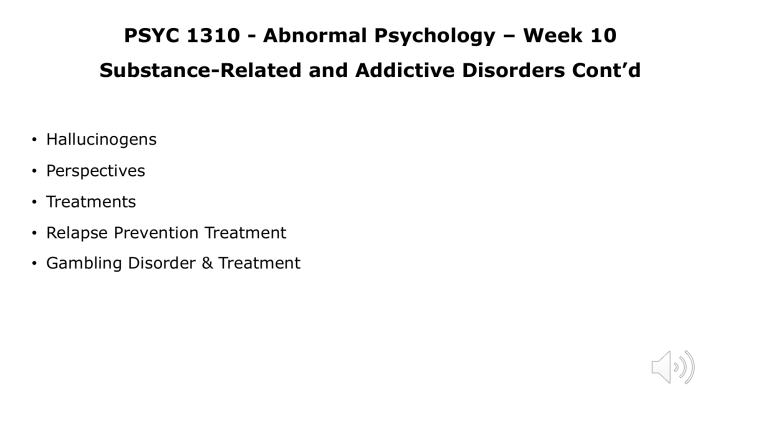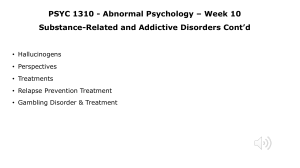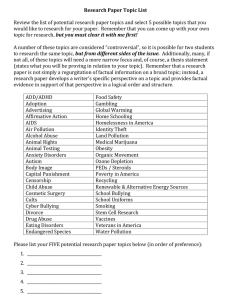
PSYC 1310 - Abnormal Psychology – Week 10 Substance-Related and Addictive Disorders Cont’d • Hallucinogens • Perspectives • Treatments • Relapse Prevention Treatment • Gambling Disorder & Treatment Hallucinogens A class of drugs that produce sensory distortions or hallucinations • May also have additional effects, such as relaxation and euphoria or, in some cases, panic Types of hallucinogens: • LSD (lysergic acid diethylamide) – A synthetic hallucinogenic drug • Effects vary by amount taken and user’s expectation, personality, mood, and surroundings • Phencyclidine, or PCP - Referred to as “angel dust” • Classified as a deliriant – a drug capable of producing states of delirium Hallucinogens Cont’d Marijuana – A hallucinogenic drug derived from the leaves and stems of the plant Cannabis sativa • Classified as a hallucinogen because in high doses it can produce perceptual distortions or mild hallucinations • In low doses, produces relaxed feelings • Associated with psychological rather than physiological dependence LEGALIZED MARIJUANA. In 2018, Marijuana was legalized in Canada. The argument was that it will reduce the illegal trade in this drug and all the associated crime. What do you think? Source: Jeffrey Rotman/Alamy Stock Photo Biological Perspectives • Neurotransmitters - Many drugs of abuse alter levels of neurotransmitters • Dopamine - Increased levels of the neurotransmitter dopamine in the brain’s reward or pleasure circuits produce feelings of pleasure • Cocaine and Heroin - Regular use of some drugs may reduce the brain’s own production of dopamine, leading to dependence on drug to produce feelings of pleasure • Serotonin and Endorphins - Other neurotransmitters such as serotonin and endorphins may also play a role in drug abuse and dependence • Genetic Factors– Evidence supports role of genetic factors in a range of substance use disorders involving alcohol, amphetamines, cocaine, heroin, and tobacco • Video on Neurotransmitters and Drugs Learning Theory Perspectives Substance-related behaviors are largely learned and can be unlearned Operant Conditioning - Drugs produce reinforcing effects such as feelings of pleasure and reductions in anxiety or depression • Can also produce relief from tension (tension reduction theory) Classical Conditioning • Cravings may represent a conditioned response to environmental cues associated with prior use of the substance • Relief from unpleasant withdrawal symptoms is a negative reinforcer to resuming drug use Observational Learning • Modeling plays an important role in determining risk of drug-related problems • Can provide social reinforcement such as approval from others • Adolescents with a parent who smokes are much more likely to smoke compared to those in families where neither parent smokes Cognitive Perspectives Cognitive Factors - evidence supports the role of cognitive factors in substance abuse and dependence • Positive expectations about drug use increases the likelihood of use • Drug use may boost self-efficacy expectations– personal expectancies we hold about our ability to successfully perform tasks • Expectancies may account for the “one-drink effect” – the tendency of chronic alcohol abusers to binge once they have a drink Psychodynamic Perspectives Alcoholism reflects traits of dependence and depression (oral traits) • Oral traits originated with fixation in the oral stage of psychosexual development. • Excessive drinking or smoking in adulthood symbolizes an individual’s efforts to attain oral gratification Sociocultural Perspectives Drinking is determined, in part, by: • Where we live • Whom we worship with • Social or cultural norms that regulate our behavior Important influences in determining substance use among adolescents and young adults: • Peer pressure • Exposure to a drug subculture • Cultural attitudes can encourage or discourage problem drinking • Rates of alcohol abuse vary across ethnic and religious groups Treatment of Substance Use Disorders Many different approaches to the treatment of substance use disorders: • Biological • Psychological • Nonprofessional • Motivational interviewing techniques used to increase readiness to make changes • Substance use often complicated by co-occurrence of other psychological disorders Biological Treatment Approaches • Detoxification – The process of ridding the system of alcohol or other drugs under supervised conditions • Disulfiram – A drug used to discourage alcohol consumption because the combination of the two produces a violent response consisting of nausea, headache, heart palpitations, and vomiting • Smoking cessation drugs – Drugs that blunt cravings for nicotine, including buproprion and varenicline • Nicotine replacement therapy – Nicotine replacements in the form of prescription gum, transdermal patches, lozenges, and nasal sprays can help smokers reduce cravings and unpleasant withdrawals • Methadone maintenance programs – The synthetic opiate methadone is used to blunt cravings for heroin and curb unpleasant withdrawal • Naltrexone – A drug used to help block the feelings of pleasure produced by alcohol, opioids, and amphetamines Culturally Sensitive Treatment of Substance Use Disorders Need to understand culturally specific factors that predict treatment response in ethnic minority groups • The use of counselors for the client’s own ethnic group is an example of a culturally sensitive treatment approach • Culturally specific factors • The use of counselors for the client’s own ethnic group • Incorporate indigenous forms of healing into treatment CULTURALLY SENSITIVE TREATMENT. Culturally sensitive therapy or treatment addresses all aspects of a person, including ethnic factors and the nurturing of pride in one’s cultural identity. Ethnic pride may help people resist the temptation to cope with stress through alcohol and other substances. Source: David Grossman/Alamy Stock Photo Nonprofessional Treatment Support Groups Promote abstinence and provide an opportunity to discuss feelings and experiences in a supportive group setting. Examples include: • Alcoholics Anonymous • Narcotics Anonymous • Cocaine Anonymous A PATH TOWARD RECOVERY. Selfhelp groups such as Alcoholics Anonymous provide support to people struggling with problems of alcohol and drug abuse. Source: Fotolia Residential Treatment Approaches Requires a stay in a hospital or therapeutic residence. • Hospitalization recommended when substance abusers: • Are not able to exercise self-control in usual environments • Cannot tolerate withdrawal symptoms • Behave self-destructively or dangerously • Most inpatient programs use an extended 28-day detoxification period, which includes: • Treatment for withdrawal symptoms • Counseling Behavioural Treatment Approaches Focus on modifying abusive and dependent behavior patterns. • Self-control training – Use “ABC” model of substance abuse: A (antecedent cues), B (abusive behavior), and C (consequences) • Contingency management (CM) programs – Provide reinforcements (rewards) contingent on performing desirable behaviors. • Aversive conditioning – Painful or aversive stimuli are paired with substance abuse or abuse-related stimuli to condition negative emotional responses to drugrelated stimuli. • Social skills training – Helps people develop effective interpersonal responses in social situations that prompt substance abuse. • Controlled drinking – Perspective that many people with alcohol abuse or dependence can develop self-control techniques that allow them to engage in controlled drinking. This is a controversial viewpoint. Relapse-Prevention Training Identify high-risk situations and learn effective coping skills for handling these situations High-risk situations may include: • Negative mood states • Interpersonal conflict • Socially conductive situations Relapse-prevention training • Importance of interpretation of any lapse or slip • Relapse-prevention training also focuses on preventing lapses from turning into full-blown relapses Gambling Disorder Classified by DSM-5 as a nonchemical addictive disorder Characterized by: • Loss of control over behavior • State of high arousal or pleasurable excitement when behavior is performed • Withdrawal symptoms • Personality characteristics overlap with chemical abusers • Cognitive errors - errors such as gambler’s fallacy and illusion of control bias are common • Many suffer low self-esteem and childhood rejection or abuse Video on Gambling Disorder Treatment of Compulsive Gambling Treatment is challenging because: • Have little insight into causes of their problems • Are reluctant to enter treatment Some success reported with: • Cognitive-behavioral programs • Peer support groups. GAMBLING, AMERICAN STYLE. Gambling is big business in the United States. Although most gamblers can control their gambling behavior, compulsive gamblers are unable to resist impulses to gamble. Many compulsive gamblers seek help only when their losses throw them into financial or emotional crisis. Source: Nazarovsergey/Fotolia Conclusion to Week 10 • Test #2 multiple choice test (20%)on Friday November 17 • Units on personality disorders and substance-related and addictive disorders • Available from 1pm to 10pm on Blackboard, 40 questions - 60 minutes • 3 types of multiple choice questions – definition, fill in the blank, and situation style questions. • Study using first your own notes, then my notes, then the textbook – focusing on the key concepts covered in each class • Rescheduling the test is only permitted with a valid medical certificate • Next unit is on Schizophrenia Spectrum Disorders





